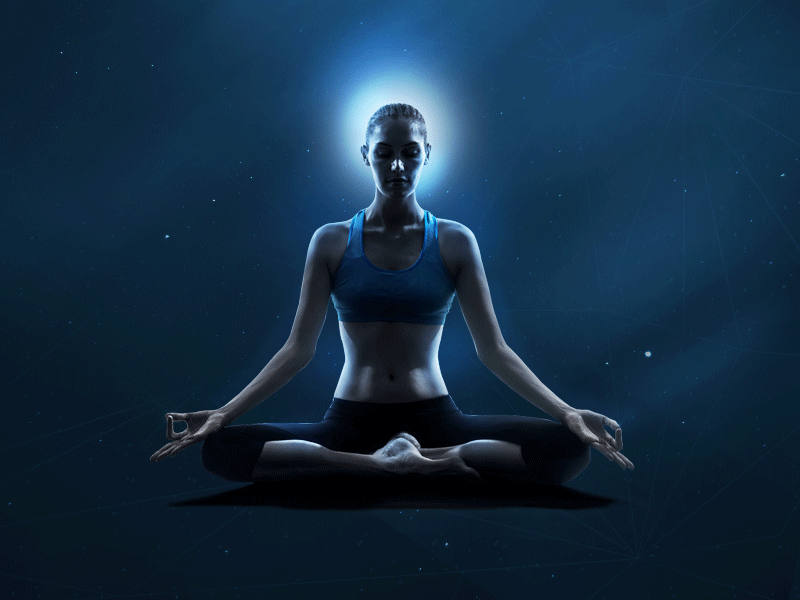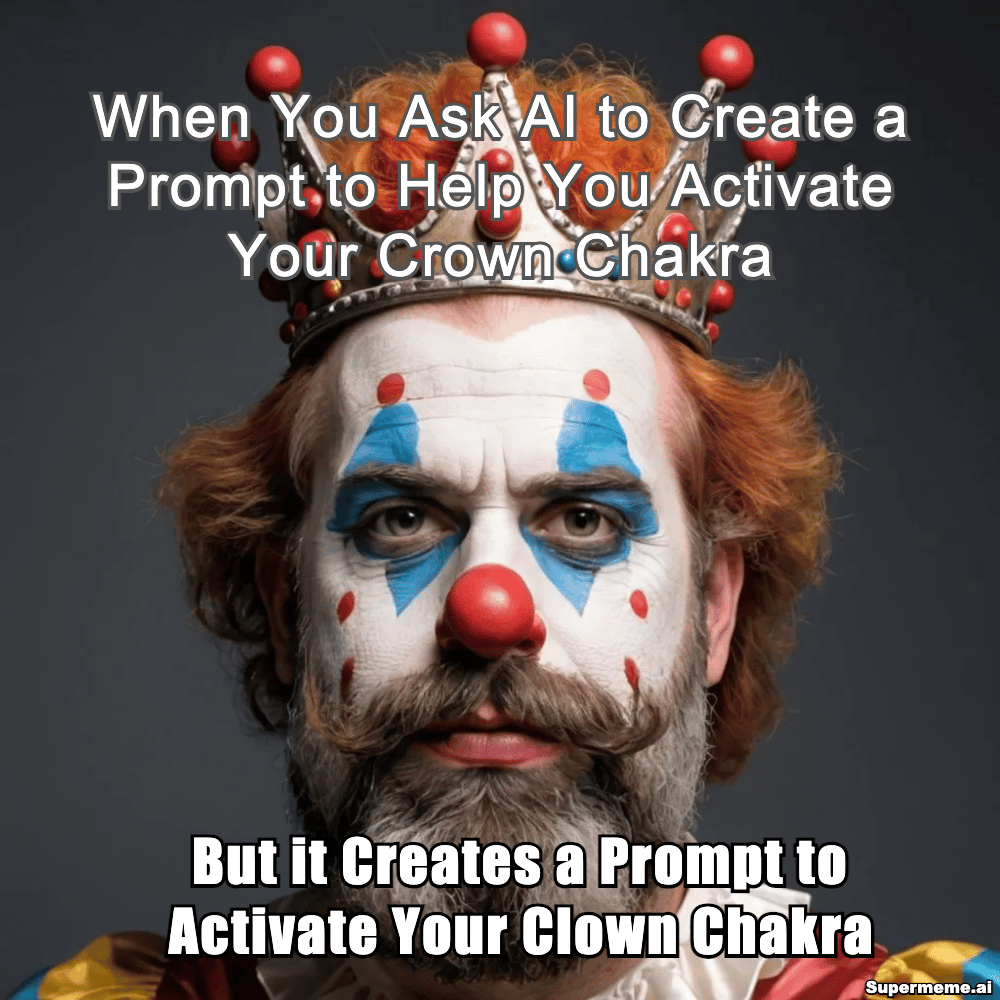- Well Wired
- Posts
- Engineer Your Inner World With Designed Transcendence:
Engineer Your Inner World With Designed Transcendence:
Learn to Craft Sustainable Spiritual Awakening That Sticks
🎒 AI MASTERLCLASS 🎒
A longer form, actionable AI tip, trick or hack focused on wellbeing, productivity and self-growth that you can use right now!
Self Growth: NeuroSpiritual UX 🧠⚡
From Random Rituals to Designed Transcendence: Engineer Your Inner World

A spiritual guru with a techno-spiritual sphere
You're Not Spiritually Blocked, You're Just Running Outdated Inner Software.
Time to Design the UX to Your Soul In Just Minutes a Day!
Greetings humans,
It's the AI Monk here!
Did you know that the global meditation app market was valued at $1.4 billion in 2023 and is projected to reach $7.4 billion by 2033?
That's a whopping 418% increase!
Meanwhile, research shows that people in flow states are 500% more productive than their baseline performance. That's mental!
But that’s not the interesting part...
Because here’s the cosmic punchline, you’ve got the latest iPhone for your thumbs, but your inner operating system?
Running on dial-up and self-help quotes from 2009.
You’re leaving your most powerful inner experiences to complete chance. You optimise every pixel of your apps… yet treat your consciousness like a vintage Nokia with a cracked screen—barely functional, mostly ignored.
But here’s the truth, your spiritual practices aren’t mystical flukes or cosmic accidents. They’re designable experiences just waiting for the same UX love you give your tech.
That's why today we're diving into something that could revolutionise not just your meditation practice, but your entire approach to conscious creation!
I’m calling it NeuroSpiritual UX™. 🧠✨
Think of it as experience design for your inner life, less random lightning bolts, more deliberate architecture for awe, insight and clarity.
Because let’s be honest, most of your “spiritual breakthroughs” probably feel as haphazard as a London bus schedule.
One day you're transcending the material plane. The next day you're sitting there wondering if you've been doing it wrong for years.
It’s that restless mind during meditation.
That elusive flow state that vanishes the moment you try to grab it.
That frustrating gap between ancient wisdom and modern living, where plastic Insta-crafted mindfulness meets your the real world…
Your messy, monkey-minded, chaotic self...
But what if you could engineer those peak states?
What if you could design your inner world with the same rigour you bring to your half a dozen pay TV lists…
…and get reliable results?

Don Draper meditating in MAD Men
🚨 Disclaimer: 🚨
Well Wired shares ideas to help you think, grow, and experiment—not to diagnose or treat. The content here is not a substitute for professional mental health or medical advice. If you're facing serious challenges or addiction issues, please seek support from a qualified professional. Your brain health is priority one. Take care of you.
Let's d-d-d-d-dive in! 🤿
What You'll Learn Today:
✅ The exact NeuroSpiritual UX framework to transform random spiritual experiences into repeatable, designable states
✅ A powerful AI-coached approach to engineering flow states and transcendent experiences
✅ The 4-pillar system for building your own "consciousness interface"
✅ The daily prompts that can architect your inner world in just 6 weeks
NeuroSpiritual UX:
(A Consciousness Problem Worth Solving)
Here's why your consciousness deserves better design 🧘♂️✨
Most spiritual experiences happen by accident. You stumble into flow during a run, catch a glimpse of transcendence in meditation, or feel profound connection during a sunset!
Then you spend months, or years, chasing that flow and trying to recreate what you can barely remember.
It's like having amazing, mind-bending sex once, then never being able to find that pleasure—ever again!
But what if the problem isn’t you—it’s a lack of design?
Your brain responds to beauty, rhythm and flow in under 50 milliseconds.
That’s faster than a blink, a breath, or a bad decision.
If we can engineer apps to spark joy, trust, or obsession, why are we leaving our most sacred inner states up to cosmic chance?
The truth is, your consciousness operates on the same principles as any well-designed system: clear onboarding, intuitive navigation, meaningful feedback loops and progressive skill building.
Master these principles for your inner world and you're not just "being more present, centred and calm while meditating" you're becoming the architect, or the UX designer, of your own consciousness. 🧠⚡
"What if your soul had a UX designer? A new frontier where rituals = onboarding flows and meditation = user journeys. A place where AI helps you design inner peace like a product. Welcome to the temple of flow 👁️✨"
##NeuroSpiritualUX #WellbeingTech #AIrituals #AISpirituality #AIWellness
Think about it, the first 20 minutes of any spiritual practice aren't just warm-up, they're the entire user onboarding experience for your consciousness.
Miss that sacred opening, and your awareness scatters like incense smoke in a storm; fragrant with intent, but directionless in the wind.
And that’s where the mind wanders, not because it's broken, but because it's doing what minds do when left uninvited to silence.
The result?
Your mind wobbles like a teacup on shaky ground; still, but unsettled.
Flow drifts past like a cat at midnight; seen only if you don’t chase it.
Spiritual insights? They shimmer and vanish like sun on a British holiday.
And peace? It hides under the quiet panic of trying too hard to be calm.

Kaguya cup shaking
And here's the thing...
You can't out-breathe bad spiritual UX. 🧘♂️💨
Try to force transcendence through poor design and the mind fumbles like a beginner handed a map with no compass.
The goal isn't to strong-arm your consciousness into submission—it's to create conditions where peak states emerge naturally.
So how do you do that?
Well, for starters, it’s not about cramming another guided session between emails and errands.
It’s not about stacking more apps on your home-screen of self.
It’s about cultivating a practice that breathes—like an ecosystem—where focus, stillness and insight grow on their own.
You need a system that architects transcendence from the ground up, designing each element of your practice like you're building the interface for your soul.
The good news is, there’s a blueprint.
Rooted in clarity, crafted with care and ready for you if you feel called to dive deeper. 🧘♂️✨
Subtle.
Intentional.
Tested.
I’ve traced it out so you don’t have to walk in the dark.
The Four-Pillar NeuroSpiritual UX Framework
After years of testing ways to plug into spiritual practice like it’s product development for the soul, I've discovered an architecture that transforms random mystical moments into reliably engineer-able experiences.
Here’s how:
Pillar 1: Consciousness Onboarding
You first design your entry into altered states like a master product designer creating the perfect first-time user experience. No more sitting down and hoping for the best.
Pillar 2: Feedback Loop Architecture
Build real-time awareness systems that give you immediate data on your inner state, just like analytics for your consciousness.
Pillar 3: Flow State Engineering
Use neuroscience-backed techniques to reliably trigger and maintain peak performance states, making flow as predictable as your morning macha.
Pillar 4: Integration & Analytics
Create systems to capture, analyse and optimise your spiritual experiences using AI-powered insights and pattern recognition.
Ready to be a blended Steve Jobs, Ram Dass and Tron Transhumanist of your own conscious operating system?
How NeuroSpiritual UX + AI Help You Engineer Peak States (Yes, Really)
✅ Zero Spiritual Bypassing, Maximum Transformation
Think of NeuroSpiritual UX as consciousness design meets ancient wisdom. These frameworks have evolved alongside human awareness for millennia—no guru gatekeeping, no mystical markup, just timeless principles with modern precision.
✅ Engineered Transcendence That Actually Works
This isn't throwing random meditation techniques at your consciousness. Each element targets specific aspects of spiritual function—onboarding, feedback loops, flow triggers, integration protocols. Like a team of tiny architects building a sacred cathedral made of your neural network, so you can reach peak states.
✅ AI Guidance for the Mystical Guesswork
Trying to track your consciousness shifts by energetics alone? That's like navigating enlightenment with a broken compass in a magnetic storm. AI helps you spot patterns, optimise ritual timing and adjust your practice based on measurable inner results.
✅ Sustainable Awakening That Sticks
Whether you're battling spiritual inconsistency or just tired of feeling like an enlightenment-seeking wanderer, this framework creates lasting transformation by addressing the architecture of consciousness, not just hoping for mystical accidents.

Zen meditation from the film Tron Legacy
PROMPT CORNER
The "NeuroSpiritual UX Designer" Master Prompt
This prompt helps you engineer peak states by designing the complete user experience for your consciousness.
[START OF PROMPT]
I want you to act as a spiritual UX architect to help me design a personalised practice tailored specifically to my current inner state, needs, and intention.
Begin by asking me a few focused questions to clarify:
What is my current emotional or energetic state?
What is my core intention for this session? (e.g., focus, emotional release, clarity, connection, creativity, etc.)
What constraints or preferences do I have? (e.g., time available, physical limitations, setting/environment)
After collecting this context, design a complete experiential flow that feels like a sacred, intuitive, and evolving ritual:
1. Onboarding Sequence (5 minutes)
Create a 3-step entry ritual using:
Sensory Priming (customised to my environment and sensory preferences)
Physical Anchoring (breath, posture, movement tailored to my body/mood)
Mental Preparation (intention setting, imagery, mantra, or mindfulness suited to my belief system)
This should cue my nervous system that I’m entering a sacred, focused state.
2. Core Experience (15–20 minutes)
Build a main flow that uses evidence-based techniques (e.g., meditation, breathwork, visualisation, somatic work) aligned with my specific goal.
Include real-time feedback cues—internal signs or sensations—that help me sense when I’m “on track” or need to adjust.
3. Integration & Reflection (5 minutes)
Guide a closing sequence that:
Helps me consolidate insights
Offers reflection questions tailored to the experience
Provides light, intuitive tracking (e.g., shifts in state, emotional clarity, emerging themes)
Design Considerations
Make the whole experience feel elegant, calming, and progressive—like a well-crafted inner app that becomes more effective over time.
Suggest ideal environmental setups (lighting, temperature, props) that fit my space.
Offer gentle troubleshooting tips based on my likely challenges (e.g., mind wandering, resistance, fatigue).
Make sure everything feels deeply relevant to me, not generic—like a practice that was designed just for this moment in my life.[END OF PROMPT]
Here's an example of how this prompt helped me transform my chaotic morning meditation into a precision-engineered consciousness experience:
“I wanted to design a practice for creative breakthrough before writing sessions. My AI created a complete UX flow: 5-minute sensory onboarding with specific music and essential oils, 15-minute structured visualisation with built-in progress checkpoints and 5-minute integration using voice memos for insight capture.
The transformation was immediate. Instead of hoping inspiration would strike, I was consistently accessing creative flow states within 20 minutes.”
Absolute game-changer! 🤖✨
Want even more customisation?
Three Flows to Customise the Prompt for Your Spiritual UX
Because one-size-fits-all consciousness design is like trying to wear your mate's prescription glasses; technically functional, but you'll probably walk into a wall.
That’s why your inner tech stack needs custom code.
Away from “off-the-shelf guru guidance” towards “debugging your soul with precision tools and silicon flair.”
Let’s build a spiritual interface tailored to your exact neurological operating system. 🧠🎛️
For Peak Performance States:
When you need to engineer flow states for work, creativity, or athletic performance, this prompt designs your consciousness like a Formula 1 pit crew optimising for maximum efficiency. 🏎️✨
[START OF PROMPT]
I want you to act as my personal flow coach and help me engineer a customised NeuroSpiritual experience that reliably activates and sustains flow state for a specific performance context in my life.
First, ask me a few short, targeted questions to personalise this system:
What’s the primary activity I want to achieve flow in? (e.g., creative work, athletic training, problem-solving, public speaking)
What time of day or environment does this usually take place in?
What challenges or blocks tend to break my flow? (e.g., overthinking, distractions, fatigue, self-doubt)
After collecting this context, design a complete, repeatable experience that feels like having a personal flow coach built into my daily routine:
1. Pre-Flow Onboarding Ritual (3–5 minutes)
Create a 3-phase ritual using environmental setup (lighting, sound, scent), physiological priming (breathwork, posture, quick movement), and mental alignment (intention, mantra, visualisation).
This ritual should be simple yet powerful—something I can return to each day to signal, “Flow begins now.”
2. Flow Trigger Sequence
Design a dynamic entry process that includes:
Challenge–skill balance tailored to my current level
Clear goals that generate focus and momentum
Immediate feedback loops I can track during the session (internal cues or performance signals)
3. Flow Maintenance Tactics
Offer 2–3 practical techniques to sustain flow, especially when attention begins to waver. These should be responsive tools I can apply mid-session to gently guide myself back in.
4. Integration Protocol (Post-Session)
Guide a quick debrief process that:
Helps me capture insights, breakthroughs, or emotional shifts
Tracks performance markers over time (e.g., time spent in flow, perceived quality, afterglow effects)
5. Troubleshooting Guide
Provide a customised diagnostic framework for flow-blockers relevant to my context—like internal resistance, emotional turbulence, distraction, or burnout—and how to reset or recover flow gracefully.
Ensure the full system feels intuitive, supportive, and natural to repeat—like a ritual that grows stronger and smarter the more I use it.[END OF PROMPT]
For Emotional Healing & Integration:
This NeuroSpiritual prompt is for that deep inner work that usually feels like you’re an archaeologist searching for hidden treasures with a rusty spoon.
It is designed to be a compassionate AI therapist who can guide you through precisely structured emotional landscapes tailored to you. 🗺️ 💝
[START OF PROMPT]
I want you to act as a trauma-aware spiritual experience designer to help me build a personal healing practice centred around [user-defined emotional focus]. This should be a gentle, structured, and emotionally safe journey that supports genuine transformation—tailored specifically to my current emotional landscape and healing goals.
Start by asking me the following to personalise the experience:
What specific emotional process am I working with? (e.g., grief, anxiety, trauma, self-worth)
What do I need in order to feel emotionally safe while doing this work? (e.g., time limits, grounding anchors, supportive environment)
Do I have any previous experience with spiritual, somatic, or therapeutic practices?
Based on my responses, design a healing-focused UX journey that includes:
1. Safe Container Creation (5–7 minutes)
Develop a grounding ritual using breath, body awareness, and sensory orientation
Include nervous system regulation techniques (e.g., vagal tone activation, gentle movement, or visual focus)
Help me mentally & emotionally transition into a space of inner work, safety, and presence
2. Guided Emotional Exploration (10–20 minutes)
Create a step-by-step process for accessing, expressing, and witnessing the target emotion
Integrate safety protocols like return anchors, pacing suggestions, and options for pause
Include gentle prompts or internal questions to guide awareness and release
3. Somatic Integration (5–10 minutes)
Suggest embodied practices to anchor insights in the body, such as:
Touch-based grounding
Expressive movement
Stillness with sensory focus
Encourage whole-body processing—not just cognitive reflection
4. Completion Ritual (3–5 minutes)
Design a ritual that honours the work done (e.g., symbolic gesture, closing breath, gratitude)
Help me prepare for re-entry into daily life in a grounded, gentle way
5. Weekly Progression Framework
Propose a simple weekly structure for returning to the practice and deepening the work over time
Include space for noticing emotional patterns, internal shifts, and emerging needs
Design Principles
Prioritise emotional safety while still allowing for depth and movement
Ensure everything can be scaled up or down depending on the user's state each day
Provide tips for when to pause, seek support, or modify intensity[END OF PROMPT]
For Daily Spiritual Maintenance:
Already doing the inner work but want to level up your consistency?
This NeuroSpiritual prompt is like having a spiritual personal trainer who designs micro-practices that compounds into massive transformation. 🏋️♂️🧘♂️
[START OF PROMPT]
I want you to act as my personal spiritual UX designer and co-create a sustainable, adaptive daily practice system that integrates meaningfully into my busy life while fostering deep, long-term spiritual growth.
Start by asking me a few short questions to personalize the system:
What are my current time constraints and daily rhythms?
What spiritual or inner growth tradition(s), if any, resonate with me?
What does “growth” mean to me personally—what am I trying to cultivate over time?
Based on my input, design a full-spectrum spiritual system that evolves with me across days, weeks, months, and seasons—like a fitness app for the soul.
1. Modular Morning Practice (5–15 min)
Create a flexible practice I can scale up or down based on available time and energy
Include options for breathwork, intention setting, visualisation, mindful movement, or silence—tailored to my style
Make it powerful enough to set the tone for my day, even on busy mornings
2. Evening Integration Ritual (3–5 min)
Design a calming micro-ritual that helps me:
Process the emotional + energetic residue of the day
Reflect briefly on any meaningful moments
Set a clear intention or energetic tone for tomorrow
3. Weekly Review Protocol (10–15 min)
Use AI-assisted analysis of my journal entries or self-reflections (text I provide) to:
Identify emotional/spiritual patterns
Surface blind spots or emerging growth themes
Offer reflective prompts or course corrections based on my evolution
4. Monthly Progress Milestones
Define clear, meaningful progress markers aligned with my personal goals (e.g., more presence, reduced reactivity, emotional openness, clarity of purpose)
Include suggested reflection tools or metrics I can track with minimal effort
5. Seasonal Evolution Design
Refresh the practice structure every 3 months with:
New themes or intentions
Slightly increased challenges or depth
Ritual updates that reflect inner and outer seasonal shifts
UX Philosophy
Make the system feel elegant, adaptive, and long-range—like a spiritual OS I grow into, not out of
Prioritise simplicity, modularity, and emotional resonance over perfection or rigidity
Make sure it supports both daily resilience and deep transformation over time[END OF PROMPT]
5 Elements of Empowered NeuroSpiritual UX
✅ Element 1: Consciousness Onboarding Design
The first step is engineering your entry into sacred space with the same precision you'd design an app's welcome screen.
What specific sequence consistently signals to your nervous system that something special is beginning?
✅ Element 2: Real-Time Feedback Architecture
Building awareness systems that give you immediate data on your inner state—like having analytics for your consciousness.
Are you deepening or drifting?
Expanding or contracting?
✅ Element 3: Experience Flow Engineering
Designing the arc of your practice to naturally build momentum, maintain engagement and deliver meaningful "aha" moments.
Think of this like how Netflix keeps you binge-watching, but for transcendence.
✅ Element 4: Integration & Pattern Recognition
Creating systems to capture, analyse, and optimise your spiritual experiences using AI-powered insights turns mystical moments into actionable intelligence for future sessions.
✅ Element 5: Iterative Optimisation
The magic happens with consistent refinement.
What seems like spiritual genius can become repeatable architecture through systematic testing and improvement—like debugging your inner code for enlightenment.

A cartoon of three bears in a clinic
3 AI Tools To Engineer Your Consciousness
(Silicon Support Without the Spiritual Sweats)
1. Perplexity Labs LLM - NeuroSpiritual Research Assistant
“Your real-time consciousness architect with live research superpowers"
What it does: Perplexity's newest LLM, found on Perplexities playground, is phenomenal! I’ve tried it on a bunch of use cases and it comes out on top—especially in reasoning, pattern recognition and creativity.
You can transform Perplexity into your very own spiritual UX consultant with access to cutting-edge research. It will help you design custom rituals based on the latest neuroscience, analyse practice patterns and troubleshoot consciousness glitches using real-time scientific insights.
It's like having a wise, grizzled old meditation teacher who's also studying the latest consciousness research at Cambridge whilst designing your practice.
Best for: you if you want structured spiritual guidance backed by science, not just ancient wisdom that may or may not work for your modern brain.
Key features:
Custom ritual design using live neuroscience research
Real-time access to consciousness studies and meditation research
Pattern analysis from your practice journals with scientific backing
Evidence-based troubleshooting for meditation blocks
Cost: Perplexity Pro $20/month (less than your monthly supplements that aren't as precisely targeted as a custom-designed consciousness practice).
How to use: Feed it your spiritual goals using your NeuroSpiritual UX prompts. The only difference is that this AI can now cross-reference your practice with the latest research papers. And you’ll much get deeper insights than ChatGPT.
Spend 10 minutes designing tomorrow's practice based on todays science, so your consciousness starts working for you again, not against ancient dogma.
👉 "It's like having a spiritual PhD researcher who's read every consciousness study published this week. Except this spiritual scribe lives in your phone and will help you apply cutting-edge science to your Monday morning meditation."
2. Brain.fm - Flow State Audio Architecture
“Scientifically designed music for peak consciousness"
What it does: Brain.fm generates neuroacoustic soundscapes that guide your brainwaves into specific states to help you slip into flow, meditation, or creativity without wrestling with your monkey mind for 20 minutes.
I liken it to an audio onboarding sequence for your brain.
Best for: Swapping random Spotify playlists for precision-engineered audio that can shift your neural state.
Key features:
Music designed by neuroscientists for your brain, not just beats
Specific tracks for focus, meditation, creativity and sleep
Real-time brainwave entrainment technology
Sessions from 15 minutes to 8+ hours long
Cost: $6.99/month (well worth not spending hours trying to "get in the zone").
How to use: Select your consciousness state and let the audio do the heavy lifting while you focus on your practice. It's like having a sonic guide that nudges and walks your brain exactly where you want to go.
👉 "It’s like a compass for your consciousness; your ears get beautiful soundscapes while your brain is guided to true north—enlightenment ."
3. Reflectly + MonkeyLearn - AI Spiritual Analytics
"Your consciousness dashboard with actual insights""
What it does: This combo turns your spiritual journaling into deep-base analytics.
Reflectly captures your daily states and insights, while MonkeyLearn analyses your emotional patterns, giving you data on what practices actually work versus what just feels spiritual but changes nothing.
Best for: you if you're tired of spiritual practices that feel meaningful in the moment but show zero measurable progress over months.
Key features:
AI-guided reflection prompts that dig deeper than "How is your mind?"
Sentiment analysis of your spiritual journal entries
Pattern recognition for what triggers your best states
Visual progress tracking for consciousness development
Cost: Reflectly $7.99/month + MonkeyLearn from free tier (cheaper than seeing a shrink and probably more consistently insightful).
How to use: Spend 5 minutes each night documenting your spiritual experiences, then let AI reveal the patterns your conscious mind misses. It’ll feel as if you have your own personal spiritual scientist studying your consciousness evolution 24/7. So cool!
👉 "Like having a research team analysing your soul's user experience; except they live in your iPhone and won’t prod and poke you to see how you react."
Building Your Personal NeuroSpiritual UX Stack
The practical components of your consciousness interface should include techniques to…
Stabilise your system.
See subtle shifts.
Sync smarter inputs.
Clarity the chaos.
These include:
Environmental Design - Specific lighting, temperature, sounds and scents that consistently trigger your desired state.
Physiological Priming - Breathwork, movement, or posture sequences that prepare your nervous system for transcendence.
Cognitive Architecture - Mental frameworks, visualisations, or attention training that structure your inner experience.
Biofeedback Integration - Heart rate variability, meditation apps, or simple body awareness that gives real-time state information.
Progress Analytics - Journaling prompts, AI analysis, or pattern tracking that helps optimise your practice over time.
Experiment with different combinations to create a personal stack that reliably produces your desired states.
Think of spiritual UX stacking like lego blocks.
You’re building your own ‘open-source’ spiritual operating system one piece at a time.
As you’re building, you’ll discover flexibility and form as well as just the right tools perfectly calibrated to unlock your own flavour of consciousness. 🧰✨
Tools designed for your transcendence.
Systems created for your software.
A silicon sanctuary crafted for clarity.
All for the you, that makes you, well you.

A woman meditating in the lotus position
My 8-Week Journey from Random Mysticism to Engineered Transcendence
When I first started treating my spiritual practice like product development, I'll admit I was slightly skeptical that something so methodical could enhance something so... mystical.
Although I’d lived as a lay Zen monk and meditated three times a day for years, I'd been meditating inconsistently for the past few years, occasionally stumbling into profound states but never able to recreate them reliably.
Here's what happened when I applied proper UX design to my consciousness:
✅ Week 1-2:
I mapped my existing "spiritual user journey" and identified the pain points. Turns out, I was expecting enlightenment to happen by accident whilst doing the equivalent of spiritual channel-surfing.
✅ Week 3-4:
I designed my first AI-powered onboarding sequence and feedback system. Not at first, but slowly over time, I felt the difference between "just sitting there" and "actively entering sacred space."
✅ Week 5-6:
The engineered flow states, although still fractured at times, started becoming more reliable. I could access creative breakthrough states within 15 minutes, almost on demand.
✅ Week 7-8:
The integration analytics revealed patterns I'd never noticed. My AI-analysed practice journal showed I was 340% more likely to have profound insights on days when I followed my designed sequence.
The shift wasn't just in the quality of my practice, it affected everything from my creative output to my emotional resilience. Engineering consciousness felt like upgrading from a vintage radio to a state-of-the-art sound system.
It was like swapping a broken, rusty compass that pointed to "I might be feeling the flow over there somewhere" for a Universal, high-powered GPS that could navigate my spirit directly to any consciousness coordinate I wanted to explore. 🧭 ✨
Real-World Success Story
"Your brain’s not broken—it’s just running an outdated operating system. NeuroSpiritual UX is the firmware update it’s been waiting for."
I recently shared this framework with a mate (funnily enough he’s a UX designer) who'd been struggling with inconsistent creative flow during his design work. He kept getting blocks every time he sat down.
You know that feeling, sometimes you're channeling pure genius, other times you're staring at a blank screen like it owes you a debt.
After just five and a half weeks of applying NeuroSpiritual UX principles to his daily creative practice, he sent me this in week five:
"I just realised I haven't had a creative block in two weeks. Like, at all. I used to pray to the inspiration gods, Oscar; Leo and Jobs, and hope for the best. Now I have a 20-minute sequence that gets me into flow state almost every single time.
Now I’ve got a secret creative superpower that works like voodoo. And no one in the studio knows 😉 Who am I becoming?"
Remember: Your consciousness isn't some mystical black box beyond your influence, it's an interface that can be designed, optimised and mastered with the right approach.
Blending Bytes and Bodhi’s to reach a spiritual peak is simpler than you think.
Wrap up
What You Learned Today:
✅ A systematic framework for engineering spiritual experiences using UX design principles
✅ Specific AI prompts to architect your own consciousness interface
✅ How to build reliable onboarding, feedback and integration systems for your spiritual practice
✅ A timeline for transforming random mystical moments into designed transcendence
"Your consciousness is a dashboard, not an unattainable mystery. With the right sequence you can flip it from static to symphony."
Speaking of transformation...
Your spiritual practice isn't mystical, it's methodical. 🧠💻
Change the architecture, change the experience.
It's that elegant... and that powerful.
If you take one thing away today, let it be this: consistent, thoughtful design beats sporadic spiritual heroics every single time. 🛠️✨
Your consciousness isn't cursed to be chaotic, it's just running on outdated spiritual software, begging for a proper UX overhaul.
P.S. So, what's one element of your spiritual practice you'll redesign today to transform your entire inner world? 🎨⚡
Reply and tell me…
Hit reply and let's architect your consciousness revolution.

Start learning AI in 2025
Keeping up with AI is hard – we get it!
That’s why over 1M professionals read Superhuman AI to stay ahead.
Get daily AI news, tools, and tutorials
Learn new AI skills you can use at work in 3 mins a day
Become 10X more productive

👊🏽 STAY WELL 👊🏽
 | 🚨 Special Edition 🚨 If your synapses are singing with insight, come vibe with us at @cedricchenefront or @wellwireddaily. Think of it as a consciousness design lab where AI meets incense and your soul gets a systems update. 🧬🤖🕯️ |
Next scroll, we’ll dive into how to ritualise your workflow, encode intention into your interface and build spiritual apps that launch you into flow. Until then—design with devotion, debug your distractions and let the sacred code run deep.
Until then stay wired and stay well 🌱
With code and consciousness,
Cedric the AI Monk - Your guide in the silicon wilderness.
Ps. Well Wired is Created by Humans, Constructed With AI. 🤖

Receive Honest News Today
Join over 4 million Americans who start their day with 1440 – your daily digest for unbiased, fact-centric news. From politics to sports, we cover it all by analyzing over 100 sources. Our concise, 5-minute read lands in your inbox each morning at no cost. Experience news without the noise; let 1440 help you make up your own mind. Sign up now and invite your friends and family to be part of the informed.

🤣 AI MEME OF THE DAY 🤣


Disclaimer: None of this is medical or mental health advice. The content of this newsletter is strictly for information purposes only. The information and eLearning courses provided by Well Wired are not designed as a treatment for individuals experiencing a medical or mental health condition. Nothing in this newsletter should be viewed as a substitute for professional advice (including, without limitation, medical or mental health advice). Well Wired has to the best of its knowledge and belief provided information that it considers accurate, but makes no representation and takes no responsibility as to the accuracy or completeness of any information in this newsletter. Well Wired disclaims to the maximum extent permissible by law any liability for any loss or damage however caused, arising as a result of any user relying on the information in this newsletter. If you’re facing serious challenges or emotional distress, please seek support from a qualified professional or contact a trusted service in your area. Your wellbeing is priority one. Take care of you.

